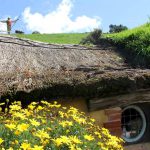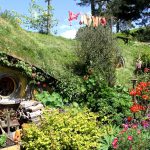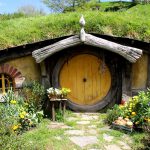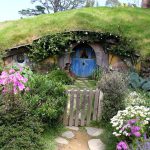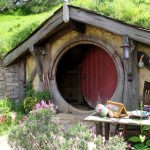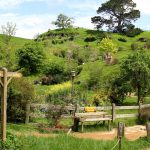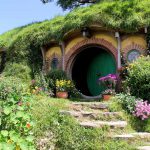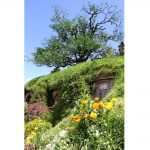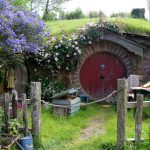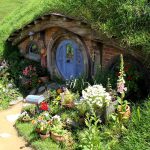
Additional Resources
Visit the Hobbiton(TM) Movie Set website for complete info including tours and days of operation as well as their Facebook page; +64 7-888 1505. Also see Peter Jackson’s Facebook page. Visit Tourism New Zealand. See awesome and amazing (c) photos from Ian Brodie Photography.
Video
Watch the 2:18 Hobbiton Movie Set – Project of the Week 8/13/18 video from Greenroofs.com on the greenroofsTV channel on YouTube. Greenroofs.com Project of the Week 8/13/18 photo credits courtesy of Linda S. Velazquez; Tourism New Zealand by Sara Orme; and Hobbiton Tours.
News
Greenroofs.com Project of the Week for August 13, 2018: Hobbiton Movie Set by Linda S. Velazquez; December 30, 2014 Greenroofs.com Explores Middle-earth at Hobbiton, NZ by Linda Velazquez on Greenroofs.com.
* Each of the 44 Hobbit home holes is unique; the total square footage of earth-sheltered greenroofs and slopes were averaged and estimated.
The vivid descriptions of the peaceful, merry, and diminutive Hobbits in J.R.R. Tolkien’s books have been brought to life through the magic of both The Lord of the Rings and The Hobbit movie trilogies directed by New Zealander Peter Jackson. The Hobbiton Movie Set represents Tolkien’s vision of the idyllic Middle-Earth village home in The Shire.
Arguably one of New Zealand’s foremost tourist attractions, the 12-acre Hobbiton(TM) Movie Set near Matamata on the North Island is situated within the picturesque 1,250 acre Alexander sheep farm. The only way to access the Hobbiton Movie Set is with a guided tour, and a successful tourism business has flourished alongside the Alexanders’ traditional sheep and cattle farming operation.
Discovered during an aerial search by Peter Jackson in September, 1998, the setting was the perfect location to film the multi-award winning The Lord of The Rings trilogy because of its untouched bucolic rolling topography with lakes and huge trees – plus the perfect specimen for the famous “Party Tree.” A 1.5km road onto the Waikato farmland site was then built by the New Zealand army to encourage the producers to build the set here.
Transformed into the heart of the Shire, where Tolkien’s fictional realm begins and ends, filming of The Fellowship of the Rings began by December of 1999. Overlooking the village from the hill at the end of Bagshot Row is Bag End, home to the most notable Hobbit hole belonging to Bilbo and Frodo Baggins, protagonists of both trilogies embodied by Martin Freemanand Elijah Wood, respectively.
Barberry hedges and trees were brought in and gardens were nurtured throughout winter. Thirty-seven temporary hobbit holes, each with their own circular doors, were created with untreated timber, 7mm ply and polystyrene covered with native turf. The original set was largely deconstructed after the conclusion of The Lord of the Rings trilogy, leaving empty Hobbit holes.
The set was permanently rebuilt in 2011 for the feature films “The Hobbit: An Unexpected Journey,” “The Hobbit: The Desolation of Smaug,” and “The Hobbit: The Battle of the Five Armies.” The latest version is a magical rendition of an idyllic 17th century English country vision and the Hobbiton(TM) Movie Set is now a permanent passive attraction complete with rolling greenroofed hobbit holes, gardens, double arched bridge, thatched stone Mill and The Green Dragon(TM) Inn with its own distinctive thatched rolling roofs offering traditional Hobbit fare and exclusively crafted Southfarthing refreshments.
In total there are now 44 unique smials, or earth-sheltered Hobbit homes, constructed of stone, concrete and brick, covered with native grasses and clovers and surrounded by gardens and orchards farmed for fresh produce. Construction required 70 set builders. The attention to construction detail of each Hobbit hole is great. Every design reflects the unique personality of its inhabitant and his or her particular occupation within The Shire.
There are approximately 2.3km (and growing) of hedges and 30 – 200 plants around each hobbit house. 1.2km of hedges and mature Hobbit-scale trees were sourced from all over the local countryside, including a 35-ton tree that was moved from a neighboring farm with the aid of two bulldozers and diggers. And all the bricks used in the chimneys and houses were made on site, with buckets of vinegar and yogurt applied to help age the wood and encourage growth on the bricks.
Except for one, the Hobbit holes are shallow exterior sets only and cannot be entered inside by visitors; they are mainly used for storage. Visitors can enter the Gourd Artist Hobbit Hole and take a peek inside – it’s approximately 10′ x 5′ and 5′ high. The filming of the inside of the Hobbit holes for all six of the Middle-Earth films was done in the Wingnut Film Studios in Wellington, New Zealand.
There are over 50 staff on a permanent basis at the Hobbiton(TM) Movie Set – up to 180 people over the peak period, including 7 – 8 gardeners during height of season, and 5 in the winter. The Alexander Farm property runs approximately 13,000 sheep and 300 Angus beef cattle hence the major sources of income are mutton, wool and beef. The Alexander brothers shear all the sheep on the property themselves, approximately every eight months.
 Greenroofs.comConnecting the Planet + Living Architecture
Greenroofs.comConnecting the Planet + Living Architecture


